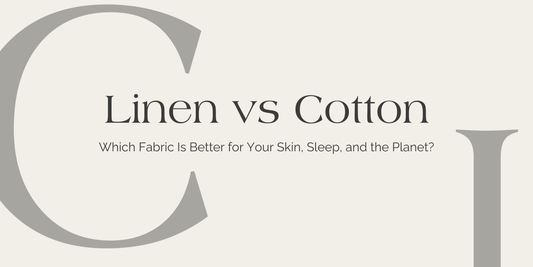For something you spend a third of your life wrapped in, bed sheets are surprisingly easy to overlook. Most people grab whatever feels soft or looks nice—without thinking too much about what makes a great sheet, well, great.
But not all bed sheets are created equal. The wrong ones can leave you tossing, sweating, or replacing them far sooner than you'd expect. Whether you're upgrading your sleep setup or buying bed sheets for the first time, here are five tips that will help you choose wisely—so you don’t have to learn the hard way.

1. Don’t Let Thread Count Fool You
Thread count gets thrown around a lot in bed sheet marketing, but it doesn’t always mean what you think it means.
For cotton, thread count measures the number of threads per square inch—but higher doesn’t always mean better. Many manufacturers inflate the number by using multi-ply yarns or artificial fillers. Beyond 400 or 500, the difference in feel is often negligible—or worse, misleading.
And for fabrics like linen, thread count doesn’t apply at all. Instead, look for GSM (grams per square meter), which tells you about the fabric’s weight and durability. A higher GSM linen sheet—like 190 to 210—will feel more substantial and last longer.
Bottom line: Thread count isn’t a guarantee of quality. Focus on fabric type, weave, and sourcing.

2. Choose Fabric for Feel—and Climate
The best bed sheets for you depend on how you sleep and where you live.
Cotton is classic and familiar. It breathes well and comes in various weaves like crisp percale or silky sateen. But even high-end cotton can trap heat or wear out faster than you’d expect.
Linen is looser-woven, naturally moisture-wicking, and ideal for hot sleepers or humid climates. It gets softer over time and has that relaxed, effortless look without the need to iron.
Bamboo and Tencel offer smooth, cool alternatives with a lower environmental footprint, though durability can vary.
Blends (like cotton-polyester) tend to be less breathable and less sustainable, even if they’re wrinkle-resistant.
Tip: Always check for your sleep style. Hot sleeper? Go breathable. Cold climate? Look for weight and warmth.

3. Natural > Synthetic Bed Sheets (For You and the Planet)
When it comes to bed sheets, what’s good for the planet is often better for your skin, too.
Natural fabrics like linen and cotton are more breathable, less likely to trap allergens, and tend to use fewer chemicals in processing—especially if you’re buying from a reputable source. They’re also biodegradable and, when grown responsibly, far more sustainable than synthetic options.
Synthetic fabrics (like microfiber or polyester blends) can feel smooth at first, but they trap heat and moisture, can irritate skin, and tend to break down faster—leading to more landfill waste.
If you’re not sure: Look for certifications like OEKO-TEX® or European Flax®, which indicate your bed sheets are made with fewer toxins and safer environmental practices.

4. Mind the Fit (It’s Not One-Size-Fits-All)
Few things are more annoying than corners that pop off your mattress mid-sleep. Before you buy, check your mattress depth—especially if you have a pillow-top or use a topper.
Many fitted sheets are made for mattresses 12 inches deep or less. If yours is taller, look for deep-pocket options (15–17 inches) to avoid tug-of-war every time you make the bed.
Flat sheets also vary. European-made bed sheets often follow EU sizing, which doesn’t always match up with US/Canada standards. When in doubt, check measurements—not just labels.

5. Invest in Quality Over Quantity
It’s easy to stock up on multiple sheet sets that look good in the store and fall apart after a few months. But spending a little more upfront on high-quality bed sheets means they’ll last longer, feel better, and save you money in the long run.
Look for brands that are transparent about where and how their sheets are made. Pay attention to fabric weight (GSM for linen, thread count range for cotton), finishing techniques, and customer reviews that mention feel and longevity—not just shipping speed.
A good set of bed sheets shouldn’t just survive the wash—it should thrive in it.

Bonus: Care Matters
Even the best bed sheets can lose their appeal with the wrong care. Wash in cool to warm water with mild detergent, skip the fabric softener (especially for linen), and tumble dry on low or line dry. This extends the life of your sheets and keeps them feeling like new.
Need more detailed care tips? Check out our full Linen Sheets Care Guide for washing, drying, and storage advice.

Final Thoughts
Buying bed sheets might seem simple—but a little knowledge goes a long way. By thinking beyond thread count, considering your sleep habits, and prioritizing natural, well-made fabrics, you’ll make a choice that supports better rest, a healthier home, and less waste.
It’s not about having a drawer full of options. It’s about finding the one set of sheets you actually look forward to crawling into night after night.
Further Reading
If you’re curious about how linen stacks up in terms of quality and longevity, our blog Good GSM for Linen Bed Sheets: How to Choose the Right Weight breaks down what fabric weight actually means—and why it matters more than thread count when it comes to everyday comfort and durability.





